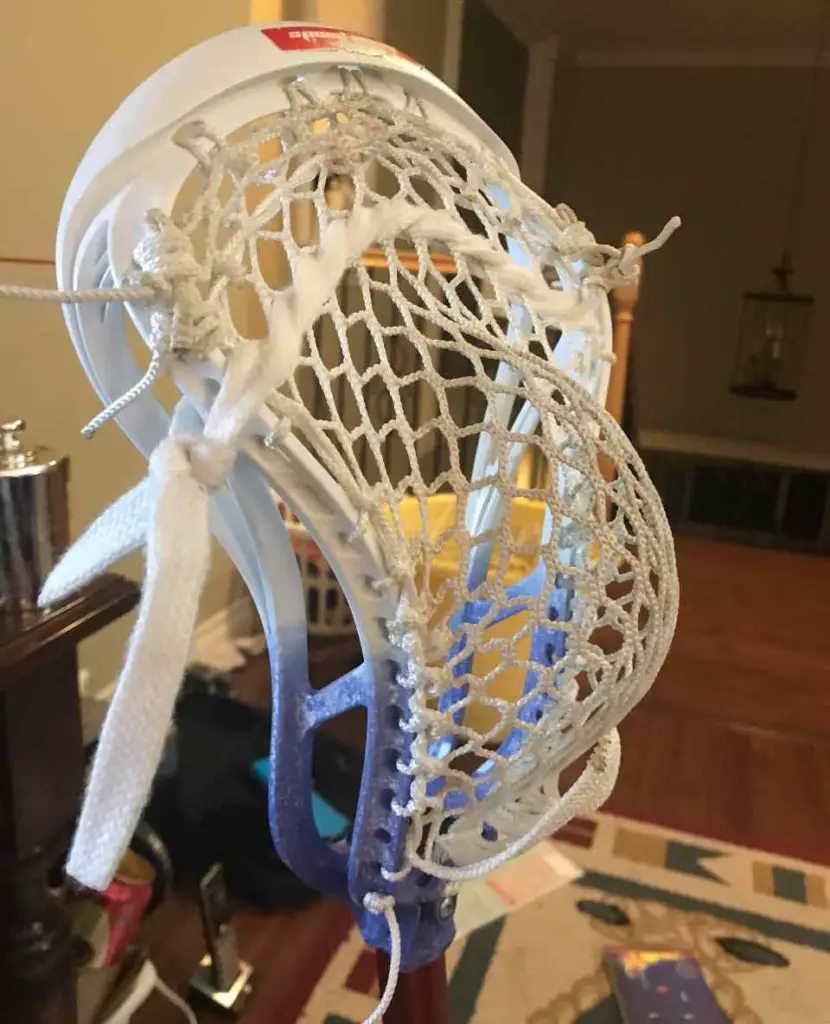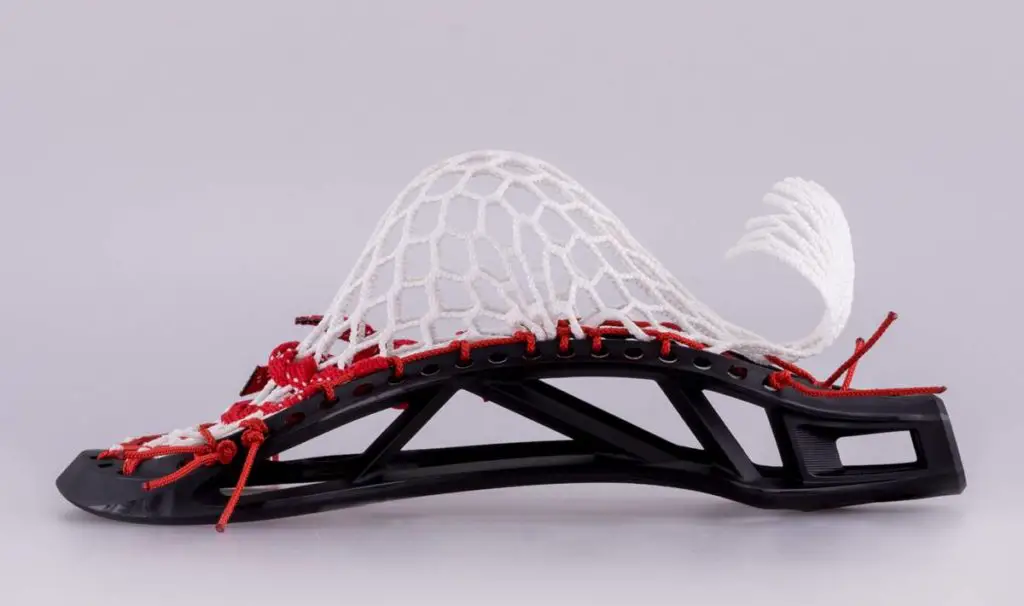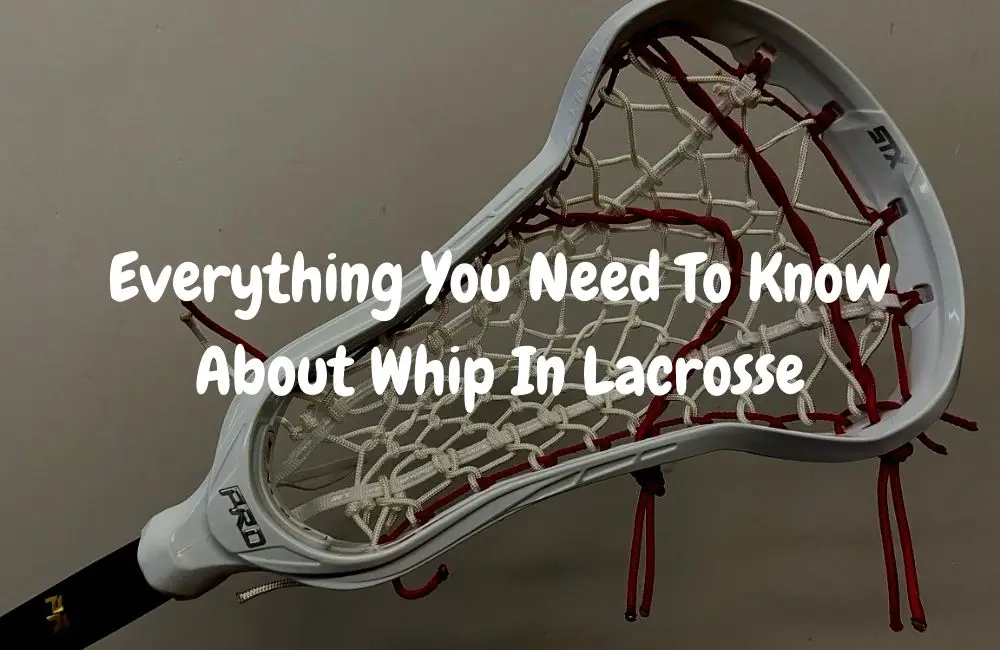Whether you just started to learn lacrosse or have been a casual lacrosse fan, it’s likely you have heard the term, whip but don’t know what it is and why it’s important. You are not alone! In fact, whip is such a loosely defined term that often causes confusion among beginner players. (Spoiler alert: it’s not a piece of equipment)
In this post, I will lay out everything you need to know about whip in lacrosse so that you can now become an expert on this subject matter and make the best quality passing or shooting from your stick.
First thing first, stringing your own pocket needs great mesh, click here to find the best lacrosse mesh on the market today.

What Is Whip?
Depending on who you ask, players often have their own versions of what the term whip stands for. Yet, the broad definition of a whip is how high or low the ball travels after it leaves the pocket. A pocket with a high whip means balls tend to travel low or crash into the ground; whereas, a pocket with a low whip means balls travel too high in the air.
In other words, whip is a relative term to describe how high or low the ball travels. It’s not a real official term; rather, a casual and convenient way for players to communicate and compare different lacrosse sticks.
What Creates Whip In A Lacrosse Stick?
The way whip is created in your stick depends on how your pocket is strung, namely pocket depth, the channel of pocket, shooting strings, bottom strings and pocket placement.
There’s no right or wrong way to adjust these aspects as the goal is to find the best amount of whip that suits your playstyle. Before we go into details of each aspect, I will first explain the two forms of whip in lacrosse. Then you will learn how different stringing aspects affect the whip and how you can apply this knowledge to enhance your pocket.
Different types of whip
There are essentially two types of whip, angle and time whip. Angle whip, as the name suggests, refers to the angle at which the ball exits the stick. A high pocket comes with a lot of angle whip as the sharp angle of the “ramp” and shorter exit shoot the ball out at a lower angle. In contrast, a low pocket comes with a less angle whip for its more gradual “ramp” resulting in a higher ball release.
Another type of whip has to do with time, a.k.a time whip. In essence, time whip refers to the amount of time it takes for a ball to exit the pocket. A pocket with high time whip travels longer so the exit is slower. A pocket with low time whip exits the net faster since the distance to roll is shorter.
Factors that influence whip

- Depth of the pocket
When talking about how stringing influences whip, the depth of your pocket is usually the first thing players look at. As a reminder, the way to judge the depth of a pocket is how low the lacrosse ball naturally sits at the lowest point inside.
In general, the deeper the pocket, the more whip the pocket has, and vice versa. Because in a shooting motion, a deeper pocket holds the ball longer which causes the ball to leave the stick at a downward angle.
Since the current rule only lets players to string pockets that are no deeper than 2 inches, players should play around with different pockets within the range to customize the whip at its finest.

- Channel of the pocket
If you string your own pocket, you would understand how the channel affects the release of the ball. Simply put, a channel inside the pocket forms an exit pathway (a loose V shape) for the release.
When the channel is strung to be tight, it causes more friction that delays the release of the ball, so it’s a high whip. When the channel is strung to be loose, it causes less friction that propels the release of the ball, so it’s a low whip.
- Shooting Strings
The reason why people add shooting strings is to change or adjust the release of a ball. Therefore, adjusting shooting strings is another common factor that adds or decreases whip.
Check out my in-depth review on shooting strings, but the basic gist of the concept is more shooters you have, the more hold, a.k.a more whip, you have in your stick.
Specifically, if you want to add more whip, tighten the shooting strings starting from top to bottom. In verse, if you want to take out some whip, loosen the shooting strings to gain more feel of the release.
- Bottom Strings
Bottom strings go hand in hand with shooting strings but work in reverse order. If you want to add more whip, you want to loosen the bottom string. If you are looking to decrease whip, pull the bottom strings tighter to make the pocket shallower so it helps to release the ball at an upward angle.
- Pocket placement
By pocket placement, I refer to the relative height of the pocket. And for obvious reasons, the placement of the pocket changes the slope of a release.
A low pocket has a gradual slope which allows the ball to travel longer then results in a higher throwing point. A high pocket has a steeper slope which shortens the travel path then causes the ball to catch early and whip downward.
Why Is Whip Important?
Although lacrosse players often have different opinions on whip and its importance, whip directly ties to the outcome of your stringing. Therefore, to answer the question if it’s important, you need to have a good level of understanding of your current shooting preference and need. For most players, whip increases throwing power and accuracy.
This explains why whip is a term that is often thrown around among intermediate and advanced players when they go, “this newly strung head has 5/10 hold and 6/10 whip.” You can only confidently judge a head after many years of experience with different stringing styles.
So my suggestion is to start and learn with no whip to develop a correct and good throwing motion; then experiment by tweaking different aspects of the pocket we went over in the previous section.
How To Adjust Whip On A Lacrosse Stick
First let’s find out if you should adjust whip on your lacrosse stick. If your lacrosse stick consistently throws down the balls into the ground, it’s a good sign that it has too much whip and needs some adjustment.
As we learned whip stems from stringing, you want to closely analyze your pocket to detect any potential stringing issues. Chances are the problem likely lies within one of the factors mentioned in the section above, which are pocket depth, pocket channel, shooting and bottom strings and pocket placement.
For more reference, check out this great video by Greg from ECD that walks through the many ways you can adjust whip on your stick.
Conclusion
In addition to your personal preference, be sure to also take into account how your position influences whip. Offensive players utilize some amount of whip for better speed and harder shots whereas defensive players and goalies like to have little to no whip for better control and long passes. Also once you find a good amount of whip, stick with it for some time before trying out a new stringing.
I hope this guide has answered your confusion and questions. Again, feel free to drop me a comment if anything is unclear. In the meantime, be sure to check out more helpful info and training content.





